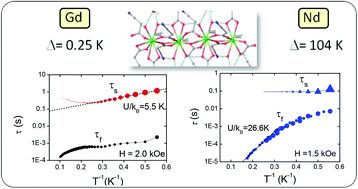Structural and magnetic properties of some lanthanide (Ln = Eu(iii), Gd(iii) and Nd(iii)) cyanoacetate polymers: field-induced slow magnetic relaxation in the Gd and Nd substitutions†
Abstract
The lanthanide(III) cyanoacetate complexes of the formula {[Ln2(CNCH2COO)6(H2O)4]·2H2O}n, where Ln = Eu (1), Gd (2), Nd (3), have been prepared and characterized by X-ray diffraction analysis. Complexes 1 and 2 are isostructural and differ from the binding scheme of the neodymium compound 3, structurally described earlier. In all cases, the cyano group of the cyanoacetate ligand is not coordinated to the lanthanide cation. The carboxylic groups exhibit different binding modes: 2-bidentate-chelating, 2-bidentate and 2-tridentate-chelating bridging for 1 and 2, and 4-bidentate and 2-tridentate-chelating bridging for the complex 3. The Eu compound 1 shows field induced paramagnetism, as expected for a non-magnetic ground state with mixing from higher states. Combining the dc magnetization and luminescence measurements the spin–orbit coupling constant λ = 343 ± 4 cm−1 was found, averaged over the two different sites for Eu in the lattice. In the Gd complex 2, a crystal field splitting of D/kB = −0.11 ± 0.01 K has been found for the S = 7/2 multiplet of the Gd(III) ion. No slow relaxation at H = 0 is observed because the low anisotropy barrier allows fast spin reversal through classical processes. The application of an external magnetic field induces two slow relaxation processes. It is argued that the first relaxation rate is caused by the resonant phonon trapping (RPT) mechanism, while the second, slower relaxation rate is due to the lifting of the Kramers degeneracy on the ground state. For compound 3 heat capacity and dc susceptibility measurements indicate that at very low temperatures the ground state Kramers doublet has strong single ion anisotropy. The energy to the next excited doublet ΔZFS/kB = 104 K has been calculated by ab initio calculation methods. The g* tensor has also been calculated, showing that it has predominant anisotropy along the z-axis, and there is an important transversal component. At H = 0 quantum tunnelling is an effective mechanism in producing a fast relaxation to equilibrium at temperatures above 1.8 K. The dipolar or exchange interactions and a sizable transverse anisotropy component in the ground state enhance the quantum tunneling probability. Under an external applied field, two slow relaxation processes appear: above 3 K the first relaxation mechanism is of the Orbach type, with an activation energy U/kB = 27 K; the slower relaxation is caused by the direct relaxation process from the ground state to the Kramers split levels by the applied field.


 Please wait while we load your content...
Please wait while we load your content...